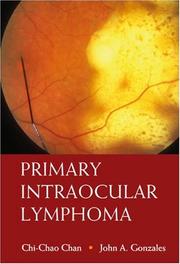| Listing 1 - 3 of 3 |
Sort by
|
Book
ISBN: 331919433X 3319194348 Year: 2016 Publisher: Cham : Springer International Publishing : Imprint: Springer,
Abstract | Keywords | Export | Availability | Bookmark
 Loading...
Loading...Choose an application
- Reference Manager
- EndNote
- RefWorks (Direct export to RefWorks)
This book describes experimental animal models that mimic common human ocular diseases: herpetic keratitis, cataract, glaucoma, age-related macular degeneration, diabetic retinopathy, uveitis, retinitis pigmentosa, Graves’ disease, and intraocular tumors. In conjunction, these models reflect the diversity and utility of tools used to study human disease. World expert clinicians discuss each model based on their clinical experience, and the text is supported by numerous photos and diagrams. Development of suitable experimental models is critical in identifying risk factors for disease, elucidating fundamental molecular mechanisms in disease progression, and providing guidance as to whether or not a particular treatment is safe and effective for humans. Like other forms of medical research, ophthalmology and vision research focuses on the investigation of disease pathogenesis and the discovery of novel therapies through in vitro and in vivo methodology. The in vivo experiments employ animal models including vertebrates (zebrafish, rodents, rabbits, and primates) and invertebrates (fruit flies and nematodes) for drug screening. In describing the most pertinent animal models of ophthalmic diseases, this book will be of interest to ophthalmologists, vision researchers, fellows, residents, and medical students.
Ophthalmology & Optometry --- Medicine --- Health & Biological Sciences --- Eye --- Diseases --- Animal models. --- Eyeball --- Eyes --- Visual system --- Face --- Photoreceptors --- Vision --- Ophthalmology. --- Laboratory animals. --- Animal Models. --- Animals, Experimental --- Animals, Laboratory --- Animals in research --- Experimental animals --- Lab animals --- Animal culture --- Laboratory organisms --- Working animals --- Animal experimentation --- Animal models in research. --- Biological models --- Laboratory animals --- Research
Digital
ISBN: 9783319194349 Year: 2016 Publisher: Cham Springer International Publishing
Abstract | Keywords | Export | Availability | Bookmark
 Loading...
Loading...Choose an application
- Reference Manager
- EndNote
- RefWorks (Direct export to RefWorks)
This book describes experimental animal models that mimic common human ocular diseases: herpetic keratitis, cataract, glaucoma, age-related macular degeneration, diabetic retinopathy, uveitis, retinitis pigmentosa, Graves’ disease, and intraocular tumors. In conjunction, these models reflect the diversity and utility of tools used to study human disease. World expert clinicians discuss each model based on their clinical experience, and the text is supported by numerous photos and diagrams. Development of suitable experimental models is critical in identifying risk factors for disease, elucidating fundamental molecular mechanisms in disease progression, and providing guidance as to whether or not a particular treatment is safe and effective for humans. Like other forms of medical research, ophthalmology and vision research focuses on the investigation of disease pathogenesis and the discovery of novel therapies through in vitro and in vivo methodology. The in vivo experiments employ animal models including vertebrates (zebrafish, rodents, rabbits, and primates) and invertebrates (fruit flies and nematodes) for drug screening. In describing the most pertinent animal models of ophthalmic diseases, this book will be of interest to ophthalmologists, vision researchers, fellows, residents, and medical students.
Science --- Animal physiology. Animal biophysics --- Ophthalmology --- Human medicine --- tumoren --- mens-dier vergelijkend onderzoek --- geneeskunde --- oftalmologie --- cataract --- primaten --- moleculaire biologie --- proefdieren

ISBN: 1281121290 9786611121297 9812771042 9789812771049 9789812704078 9812704078 9781281121295 6611121293 Year: 2007 Publisher: Hackensack, NJ World Scientific
Abstract | Keywords | Export | Availability | Bookmark
 Loading...
Loading...Choose an application
- Reference Manager
- EndNote
- RefWorks (Direct export to RefWorks)
Essential reading for both medical students and academics in the fields of ophthalmology, neurology and oncology, this is the first textbook to cover the subject of primary intraocular lymphoma (PIOL). The book serves to educate ophthalmologists, neurologists and oncologists on a disease process that is often difficult to diagnose. To help readers recognize the malignancy, a presentation of common and less frequently occurring clinical manifestations of the disease is given. The book provides ophthalmologists the guidelines on current diagnostic and therapeutic modalities as well as the histor
Reticulo-endothelial system --- Lymphomas. --- Germinoblastomas --- Immunoblastomas --- Lymphoma --- Non-Hodgkin's lymphoma --- Reticulolymphosarcomas --- Sarcoma, Germinoblastic --- Sarcoma, Immunoblastic --- Lymphoproliferative disorders --- Reticuloendothelial granulomas --- Tumors. --- Tumors --- Eye Neoplasms. --- Lymphoma.
| Listing 1 - 3 of 3 |
Sort by
|

 Search
Search Feedback
Feedback About UniCat
About UniCat  Help
Help News
News